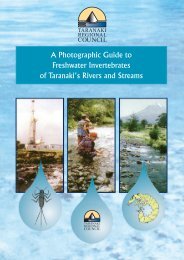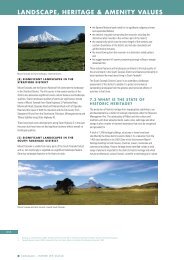Annual report 2006-2007 - Taranaki Regional Council
Annual report 2006-2007 - Taranaki Regional Council
Annual report 2006-2007 - Taranaki Regional Council
Create successful ePaper yourself
Turn your PDF publications into a flip-book with our unique Google optimized e-Paper software.
10. Water quality in the Kahouri catchment<br />
92<br />
The water quality of the Kahouri Stream has been assessed briefly under separate<br />
headings in regard to both chemical and biological aspects. In particular, emphasis<br />
has been placed upon components in the various discharges that have the potential<br />
to influence its suitability for various water purposes including instream uses such as<br />
wildlife and aquatic biota.<br />
The chemical water quality in the main Kahouri Stream channel could be described<br />
as good, bearing in mind the influence of catchment land use and channel and<br />
riparian vegetation characteristics. As well as waste contribution from the various<br />
industries monitored as part of the Kahouri programme, there are wastes from<br />
various agricultural activities both of a point source and diffuse nature which also<br />
influence the water quality of the stream.<br />
A concern with the abattoir discharge is the contribution of nutrients to the Kahouri<br />
catchment and, ultimately, to Lake Rotorangi. Previous work has demonstrated that,<br />
after the Stratford municipal oxidation pond discharge, the discharge from the<br />
abattoir is the second most significant single point source contributor of nutrients to<br />
the upper Patea catchment. Monitoring of Lake Rotorangi indicates that the lake<br />
continues to be mesotrophic to mildly eutrophic, suggesting that nutrient enrichment<br />
is not occurring or is occurring at a very slow rate. It is noted that the combined<br />
discharges from dairy farms (both treated dairy shed wastes and pastoral run-off) are<br />
also comparatively significant sources of nutrients.<br />
In April <strong>2007</strong> the waste discharge from the <strong>Taranaki</strong> Abattoir raised the biochemical<br />
oxygen demand in the Kahouri Stream by more than 1 g/m 3 and therefore did not<br />
comply with special condition 1 of the Company’s discharge consent. There was also<br />
an increase in nutrient concentrations downstream of the discharge. Associated with<br />
these increases were some significant changes in macroinvertebrate community<br />
composition in the Kahouri Stream.<br />
Treated domestic waste from Transpower NZ Limited contributes a relatively minor<br />
amount of nutrients and both water chemistry and biological monitoring indicated<br />
no deterioration in water quality as a result of this discharge.<br />
Discharges from <strong>Taranaki</strong> Galvanizers have in the past had a significant influence on<br />
the water quality of the Kahouri Stream, particularly the small tributary which<br />
continues to receive zinc leachate. This is important from a toxicity standpoint.<br />
Stream biota, including macroinvertebrates, algae and fish species, are variously<br />
sensitive to zinc in soft waters of low buffering capacity such as those of the Kahouri<br />
system. Dilution effects reduce the zinc concentration to ‘safe levels’ (as defined by<br />
United States Environmental Protection Agency guidelines for aquatic species and<br />
ANZECC guidelines) at a point somewhere above the confluence of the large<br />
tributary with the main Kahouri Stream.<br />
It was noted in the 1998-1999 monitoring <strong>report</strong> that zinc levels in the small tributary,<br />
now piped, receiving the zinc leachate had fallen to one fiftieth of the concentration<br />
first found. The levels measured during the <strong>2006</strong>-<strong>2007</strong> monitoring year indicate that<br />
the amount of zinc leaching from the site appears to be continuing to stabilise.<br />
However, it is important to recognise that there have been a number of ‘'pulses’ of














